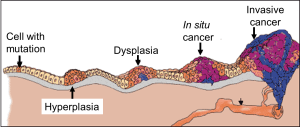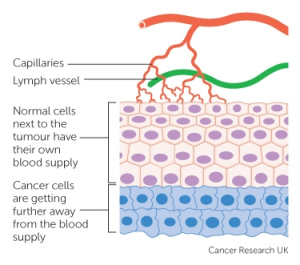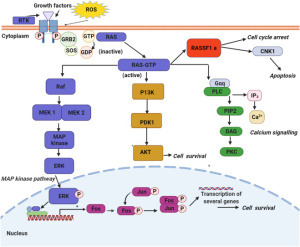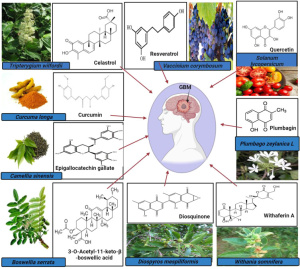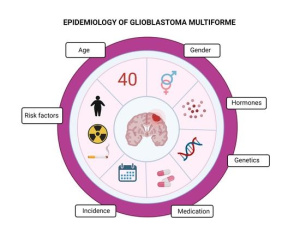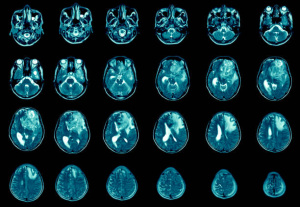
How do cancers get bigger?
Cancer cells stay in the specific body tissue from which they have developed. Cancer cells grow and divide to create more cells and create a tumor that can consist of millions of cancer cells. Cancer cells can stay within the membrane of a specific body tissue, or it can be invasive (breaks through the membrane). As the tumor gets bigger the center of it gets further away from the blood vessels which means it has less oxygen and nutrients. Without a blood supply tumor can’t grow bigger than a pin head. Cancer cells send signals, called angiogenic factors that stimulate 100s of new small blood vessels that allow tumors to continue growing.
Treatments [6]
Glioblastoma treatment depends on various factors such as the age and health of the patient, the size and location of the tumor, and whether the tumor has spread to other parts of the brain. The current standard treatment for glioblastoma usually involves a combination of surgery, radiation therapy, and chemotherapy.
- Surgery: Surgery is the first line of treatment for glioblastoma, and the goal is to remove as much of the tumor as possible without causing damage to the surrounding healthy brain tissue.
- Radiation Therapy: Radiation therapy uses high-energy X-rays or other types of radiation to kill cancer cells and shrink tumors. It is often given after surgery to destroy any remaining cancer cells.
- Chemotherapy: Chemotherapy uses drugs to kill cancer cells. It can be given orally or intravenously, and it is often used in combination with radiation therapy.
- Tumor Treating Fields: Tumor Treating Fields (TTFields) is a new treatment option that involves using electric fields to disrupt the division of cancer cells. This treatment is usually used in combination with chemotherapy.
- Immunotherapy: Immunotherapy is a type of treatment that helps the immune system fight cancer. It is still being studied for its effectiveness in treating glioblastoma.
- Clinical Trials: Clinical trials are research studies that test new treatments for glioblastoma. Patients who participate in clinical trials may have access to new treatments that are not yet available to the general public.
Alternative medicine
Alternative medicine has been explored as a potential adjunct therapy in the treatment of glioblastoma. Some alternative therapies, such as meditation and acupuncture, may help manage symptoms such as pain, nausea, and anxiety. Others, like herbal supplements and dietary modifications, may have potential as adjuvant therapies, though more research is needed to establish their efficacy and safety. While alternative medicine should not be used as a substitute for conventional medical treatments, integrating complementary therapies into a comprehensive treatment plan may improve quality of life for glioblastoma patients and may help support their overall health and well-being.
Environmental Factors
There is ongoing research exploring the potential role of environmental factors in the development of glioblastoma. Exposure to certain chemicals, such as pesticides and industrial solvents, has been linked to an increased risk of developing brain tumors, including glioblastoma. Additionally, some studies have suggested that radiation exposure, particularly during childhood, may also increase the risk of developing glioblastoma later in life. While the link between environmental factors and glioblastoma is not fully understood, these findings highlight the importance of understanding the potential risk factors associated with this disease and taking steps to minimize exposure to harmful substances.
Sources
[1] Kasa, T. (n.d.). Magnetic resonance imaging finding 5 cm isodense mass with… iStock. Retrieved March 22, 2023, from https://www.istockphoto.com/photo/magnetic-resonance-imaging-finding-5-cm-isodense-mass-with-ill-defined-margin-and-gm1339217716-419614241?utm_campaign=srp_photos_noresults&utm_content=https%3A%2F%2Fwww.pexels.com%2Fsearch%2Fglioblastoma%2F&utm_medium=affiliate&utm_source=pexels&utm_term=glioblastoma
[2] Brain tumor development. Brainlab.org. (n.d.). Retrieved March 22, 2023, from https://www.brainlab.org/get-educated/brain-tumors/learn-brain-anatomy-basics/brain-tumor-development/
[3] How cancers grow. Cancer Research UK. (2021, February 8). Retrieved March 22, 2023, from https://www.cancerresearchuk.org/about-cancer/what-is-cancer/how-cancers-grow
[4] Daniel, P. M., Ebert, P. J. R., Massard, C., Shankar, D. B., Dworkin, S., Sengupta, R., Butcher, R. W., Fonseca, B. D., Carriere, A., Yu, C. F., Maehama, T., Alessi, D. R., Kleber, S., Chuang, C. F., Okada, S., Chiu, W.-T., Brown, C. K., Stylli, S. S., Verhaak, R. G. W., … Network, C. G. A. R. (2019, January 30). Understanding and exploiting cell signalling convergence nodes and pathway cross-talk in malignant brain cancer. Cellular Signalling. Retrieved March 22, 2023, from https://www.sciencedirect.com/science/article/pii/S0898656819300208?via%3Dihub
[5] Elsevier Masson. (2021, July 19). Natural bioactive molecules: An alternative approach to the treatment and control of glioblastoma multiforme. Biomedicine & Pharmacotherapy. Retrieved March 22, 2023, from https://www.sciencedirect.com/science/article/pii/S0753332221007101
[6] Glioblastoma multiforme. AANS. (n.d.). Retrieved March 22, 2023, from https://www.aans.org/en/Patients/Neurosurgical-Conditions-and-Treatments/Glioblastoma-Multiforme
[7] Grochans, S., Cybulska, A. M., Simińska, D., Korbecki, J., Kojder, K., Chlubek, D., & Baranowska-Bosiacka, I. (2022, May 13). Epidemiology of glioblastoma multiforme–literature review. MDPI. Retrieved March 22, 2023, from https://www.mdpi.com/2072-6694/14/10/2412
